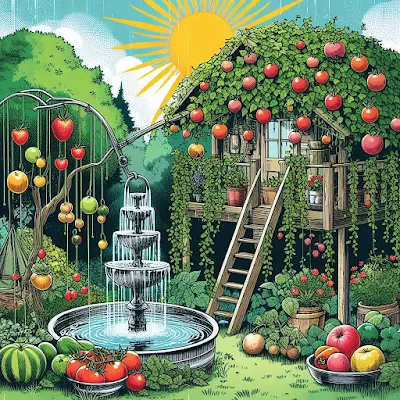Surviving the Blaze: Top Plants for Full Sun and Blazing Hot Heat Zones🔥
Welcome to the sizzling world of gardening in full sun and blazing heat zones! If you've ever felt challenged by the idea of creating a vibrant garden in scorching hot conditions, fear not – you're in the right place.
In this simple guide, we'll explore a handpicked selection of resilient plants that not only survive but thrive under the intense glare of the sun.
Whether you're battling relentless summer heat or simply seeking to revitalize your outdoor space, let's embark on a journey to discover the secrets of cultivating lush, flourishing gardens in the face of adversity.
For full sun and blazing heat areas and zones, it's essential to choose plants that are well-adapted to thrive in such challenging conditions.
Here are some of the best plants that can handle full sun and extreme heat:
1. Succulents and Cacti
Succulents and cacti are well-known for their ability to thrive in hot, dry conditions. They store water in their fleshy leaves and stems, allowing them to withstand prolonged periods of drought and intense sunlight. Popular varieties include agave, aloe, sedum, echeveria, and prickly pear cactus.
2. Lavender
Lavender is a sun-loving perennial herb that thrives in hot, dry climates. It features fragrant foliage and beautiful spikes of purple flowers that attract pollinators like bees and butterflies. Lavender is also drought-tolerant once established, making it an excellent choice for full sun gardens.
3. Lantana (Lantana camara):
Lantana is a heat-tolerant flowering plant that produces clusters of colorful blooms in shades of red, orange, yellow, and pink. It attracts butterflies and hummingbirds and is highly drought-tolerant once established. Lantana is perfect for adding vibrant color to sunny borders, containers, and hanging baskets.
4. Blanket Flower (Gaillardia spp.):
Blanket flower is a hardy perennial that thrives in hot, sunny conditions. It produces daisy-like flowers in bold hues of red, orange, and yellow, attracting pollinators like bees and butterflies. Blanket flower is drought-tolerant and low-maintenance, making it an excellent choice for hot, dry landscapes.
5. Black-Eyed Susan (Rudbeckia spp.):
Black-eyed Susan is a native wildflower known for its cheerful yellow blooms with dark centers. It thrives in full sun and well-drained soil, making it ideal for hot, dry conditions. Black-eyed Susan attracts pollinators and adds a pop of color to garden beds, borders, and wildflower meadows.
6. Agapanthus (Agapanthus spp.):
Agapanthus, also known as Lily of the Nile, is a sun-loving perennial with large clusters of blue, purple, or white flowers atop tall stems. It thrives in hot, sunny conditions and is drought-tolerant once established. Agapanthus adds a touch of elegance to garden borders, containers, and mass plantings.
7. Russian Sage (Perovskia atriplicifolia):
Russian sage is a heat-tolerant perennial with aromatic foliage and airy spikes of lavender-blue flowers. It thrives in full sun and well-drained soil, making it perfect for hot, dry climates. Russian sage is drought-tolerant and deer-resistant, making it a low-maintenance option for sunny landscapes.
8. Yarrow (Achillea spp.):
Yarrow is a hardy perennial with fern-like foliage and clusters of flat-topped flowers in shades of pink, yellow, white, and red. It thrives in full sun and is drought-tolerant once established. Yarrow attracts pollinators and is suitable for sunny borders, wildflower meadows, and rock gardens.
These plants are well-suited to thrive in full sun and blazing heat zones, providing you with a beautiful and resilient landscape even in the most challenging conditions. When planting, be sure to provide adequate irrigation until the plants become established, and consider adding a layer of mulch to help retain soil moisture and suppress weeds.
Mastering the Heat: Creating Flourishing Gardens in Full Sun and Blazing Heat Areas and Zones
Gardening in full sun and blazing high heat zones presents a unique set of challenges, but with careful planning and proper care, you can create a beautiful and thriving garden that withstands the hottest of days.
Here are some tips you need to know to get started:
1. Choose Heat-Tolerant Plants:
Selecting the right plants is crucial for success in hot and sunny conditions. Look for varieties that are well-adapted to high temperatures and drought, such as succulents, cacti, and heat-loving perennials like lavender and lantana.
2. Provide Adequate Watering:
Proper watering is essential for maintaining healthy plants in hot climates. Water deeply and infrequently to encourage deep root growth and drought tolerance. Consider installing a drip irrigation system or soaker hoses to deliver water directly to the roots while minimizing water loss through evaporation.
3. Mulch for Moisture Retention:
Apply a layer of organic mulch, such as shredded bark or wood chips, around your plants to help retain soil moisture, suppress weeds, and regulate soil temperature. Mulching also helps to prevent soil erosion and compaction, promoting overall plant health.
4. Plant in Well-Drained Soil:
Ensure that your garden beds have well-drained soil to prevent waterlogging and root rot, especially during heavy rainfall or irrigation. Incorporate organic matter, such as compost or aged manure, into the soil to improve its texture and fertility.
5. Provide Shade and Shelter:
Create shade and shelter for your plants by using structures like pergolas, arbors, or shade cloth. Planting tall, heat-tolerant trees or shrubs can also provide natural shade and cooling for your garden beds.
6. Time Your Planting:
Plan your planting schedule to take advantage of cooler temperatures in the early morning or late afternoon. Avoid planting during the hottest part of the day to minimize transplant shock and stress on newly established plants.
7. Monitor and Adjust:
Keep a close eye on your garden and monitor soil moisture levels, plant health, and pest activity regularly. Adjust your watering schedule and provide additional shade or protection as needed to ensure the optimal growing conditions for your plants.
8. Embrace Drought-Tolerant Landscaping:
Consider incorporating drought-tolerant landscaping techniques, such as xeriscaping or native plant gardening, into your outdoor space. These approaches prioritize water conservation and sustainability while creating visually stunning landscapes that thrive in hot and arid climates.
9. Experiment and Learn:
Gardening is a journey of discovery, so don't be afraid to experiment and learn from your experiences. Keep a gardening journal to track your successes and failures, and don't hesitate to seek advice from local gardening experts or online resources.
10. Enjoy the Fruits of Your Labor:
Finally, take the time to sit back, relax, and enjoy the beauty and tranquility of your garden oasis. Whether you're sipping lemonade on the patio or hosting a garden party with friends and family, your flourishing garden is sure to be a source of pride and joy.
By following these tips and techniques, you can create a thriving garden that not only survives but thrives in full sun and blazing heat zones. With a little planning, care, and perseverance, you'll be rewarded with a beautiful outdoor space that brings joy and inspiration for years to come.

 The Crunchy Moon
The Crunchy Moon



